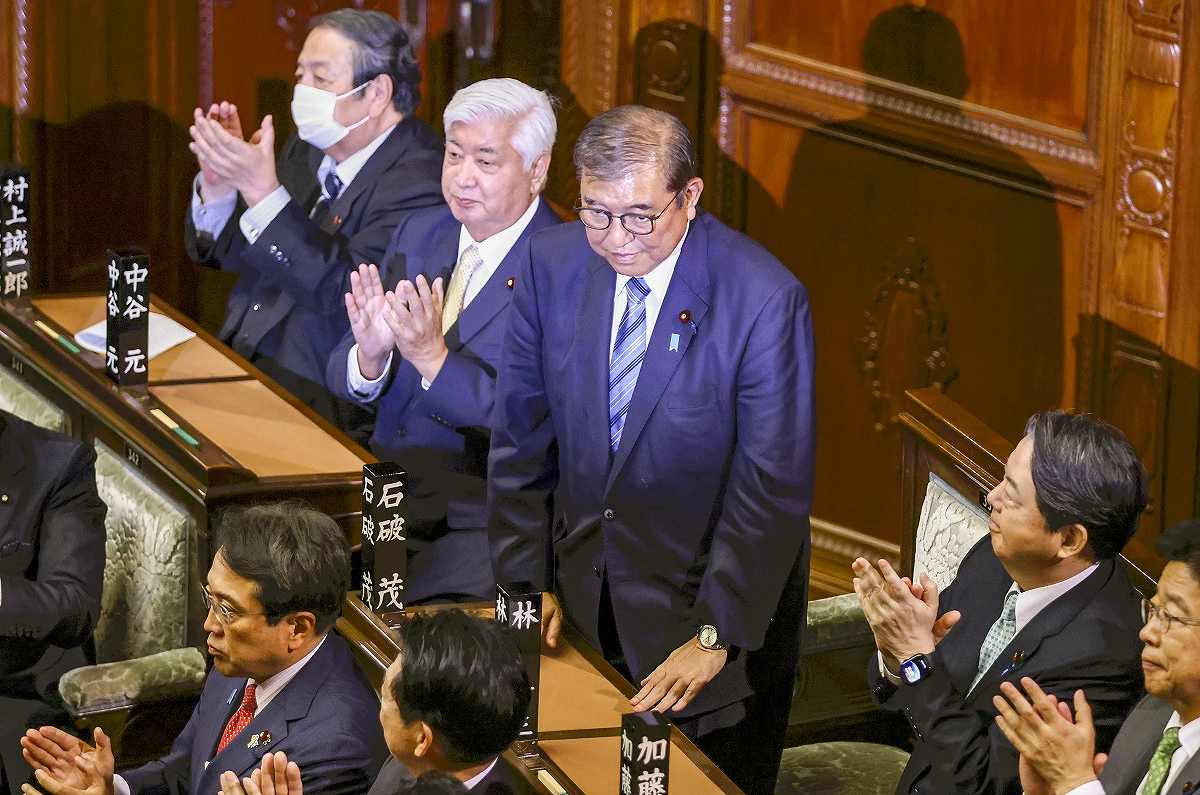LDP Faces Struggle To Survive As Minority Ruling Party; Ishiba Must Woo Opposition To Get Anything Done

Shigeru Ishiba, center, bows after being chosen as prime minister in a House of Representatives plenary session in the Diet on Monday.
8:00 JST, November 16, 2024
The Japanese people punished the Liberal Democratic Party for its political funds scandals in the House of Representatives election on Oct. 27, but still allowed it to remain as the leading party. This mixed result plunges politics into absolute turmoil.
The ruling coalition of the LDP and Komeito suffered a crushing defeat in the latest lower house election. The LDP lost 56 seats, falling from 247 to 191, and Komeito lost eight seats, falling from 32 to 24. Even combined, they fell short of the 233 seats needed to secure a simple majority. The coalition that had boasted an absolutely stable majority found itself reduced to a minority ruling coalition.
On the other hand, none of the opposition parties surpassed the LDP’s number of seats. Even though the Constitutional Democratic Party of Japan made a leap by adding 50 seats, that got it only as far as 148, also falling far short of a majority. The Japan Innovation Party finished in third place with 38 seats and the Democratic Party for the People was fourth with 28 seats, but neither of these two parties have any intention to go along with the CDPJ as a coalition partner as they can’t close their eyes to significant gaps in fundamental policy areas such as nuclear energy and security.
In fact, those two parties refrained from voting for CDPJ President Yoshihiko Noda in the Nov. 11 vote to designate the prime minister in a special Diet session, thereby paving the way for LDP President Shigeru Ishiba to be elected.
However, the political foundations of the Ishiba Cabinet are still weak. Not only is it unable to pass any budget bill or legislation without opposition support, but it also exists under the threat of a potential no-confidence motion.
For the LDP to survive as a minority ruling party, Ishiba is asking the opposition DPFP to give its support on a policy-by-policy basis by adopting some of the DPFP’s election pledges. This type of political maneuver is called a “partial coalition.”
For the time being, the LDP is asking the DPFP to approve a supplementary budget plan for fiscal 2024 in an extraordinary Diet session to be convened later this year, and the DPFP has made it a condition that the LDP must accept their signature policies including reviewing the so-called ¥1.03 million barrier, referring to the threshold above which annual income is subject to income tax. Raising this threshold would effectively increase workers’ take-home pay.
Besides that, the LDP is having separate policy consultations with the CDPJ and the JIP, hoping to obtain some agreements with them so that they will vote for the supplementary budget plan.
Although I understand it’s too early to predict Ishiba’s future as prime minister, I will try to sketch out some possible scenarios.
The first test will be the vote on the supplementary budget plan. If Ishiba can’t persuade the DPFP to vote for the plan, he may be forced to resign. This means he needs to realize the DPFP policy of reviewing the ¥1.03 million barrier — but there is strong sentiment against that among LDP and government policymakers, as the central and regional governments would be forecast to lose about ¥7 trillion to ¥8 trillion in revenue. They argue that the government has no capacity to spare. So Ishiba needs to persuade such policymakers ahead of the DPFP, but he hasn’t shown clear leadership in that regard so far.
If he can manage to get support from the DPFP, Ishiba’s next test will be whether he can pass the fiscal 2025 budget proposal and survive the upcoming ordinary Diet session that starts in January.
Survival may be more difficult for Ishiba in the ordinary session than in the extraordinary one, because opposition parties including the DPFP may go on the offensive to lay the groundwork for their campaigns for the House of Councillors election to be held next summer.
Opposition parties may hesitate to hinder approval of the budget as it might cause trouble for economy. Yet even if they cooperate up to that point, they can finish the Ishiba Cabinet off by submitting a no-confidence motion after voting for the budget proposal. That’s the scenario we saw 30 years ago, when then Prime Minister Tsutomu Hata, who led a minority ruling coalition, was forced to resign.
Another scenario is that Ishiba might be removed as prime minister by LDP rivals before the summer. His reputation as a popular, outspoken statesman has sharply suffered since he became prime minister, so many of them think he is incapable of leading the party to victory in the upper house election. Therefore, they hope to campaign with a brand-new prime minister. Moreover, some of them envision holding upper and lower house elections on the same day under a new leader in the hope that the LDP can escape its position as part of a minority ruling coalition.
A minority ruling party rarely lasts long. Hata was only able to stay in the job for 64 days, the second shortest tenure since World War II. Can Ishiba make himself an exception?
Political Pulse appears every Saturday.

Satoshi Ogawa
Satoshi Ogawa is the editor of the Political News Department of The Yomiuri Shimbun.
"Editorial & Columns" POPULAR ARTICLE
-

Corporate Interim Earnings: Companies Must Devise Ways to Overcome Trump Tariffs
-

Violations of Subcontract Law: Major Automakers Must Eliminate Old Practices
-

Local Governments’ Tax Revenues: Devise Ways to Correct Imbalances in Tax Sources
-

Takaichi’s Summit with Economics-Minded Trump Successfully Advanced Japan’s Security Interests
-

New Nuclear Threat: China Seeking to Follow U.S., Russia in Military Expansion
JN ACCESS RANKING
-

Govt Plans to Urge Municipalities to Help Residents Cope with Rising Prices
-

Japan Prime Minister Takaichi Vows to Have Country Exit Deflation, Closely Monitor Economic Indicators
-

Japan to Charge Foreigners More for Residence Permits, Looking to Align with Western Countries
-

Essential Services Shortage to Hit Japan’s GDP By Up to ¥76 Tril. By 2040
-

Japan GDP Down Annualized 1.8% in July-Sept.





















